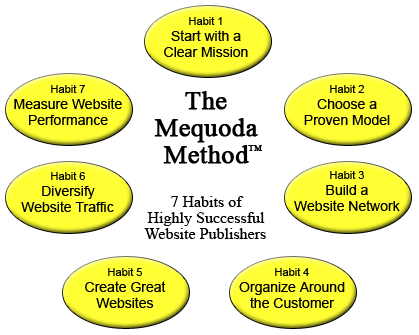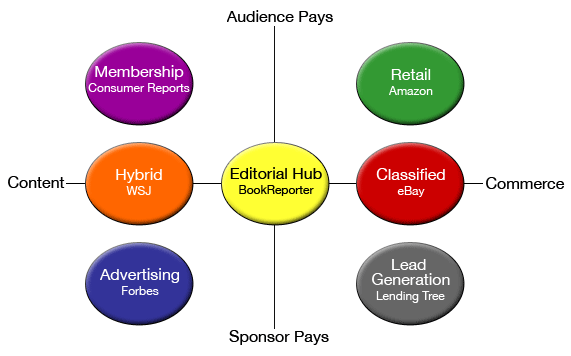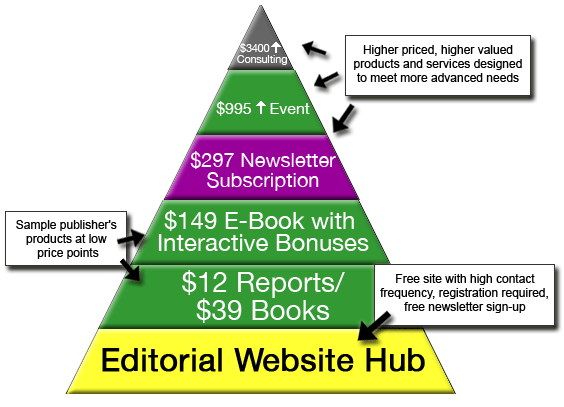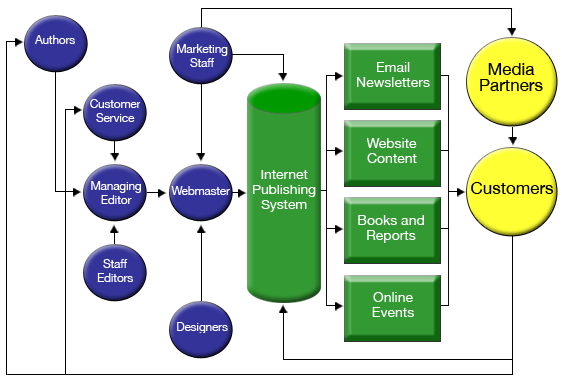Successful website publishing in 2005 means creating happy users and healthy profits. Without both, no website will exist for long. All of the successful website publishers we’ve studied have one thing in common: a consistent management system for achieving success that includes a number of key behaviors that are repeated over and over to become organizational habits. The seven habits that we’ll describe in this report can be used to form a powerful, self-reinforcing website management system we call The Mequoda System. As Stephen Covey points out in his bestselling Seven Habits of Highly Effective People, habits are the most powerful thing on earth. If you choose a set of good practices for any business and turn them into habits, the odds of success are greatly enhanced.
With that in mind, we’ve studied thousands of successful and not-so-successful website publishers to arrive at seven best business practices that can be used together to create The Mequoda System. The Mequoda System, when run as a repeating cycle of management behaviors, creates an audience-driven continuous-improvement website management system. The system can be used to launch a new website property, or to manage, maintain and improve an existing website. Let’s explore our seven habits of highly successful website publishers.

Habit 1: Start with a Clear Mission
A Mequoda™ Website Mission answers three key questions:
- Who is your website serving?
- What value is your website providing to the user?
- How do you measure website success?
The answers to these three questions form the foundation for your website strategy, which in turn drives your website goals, tactics and metrics. This system of goals, tactics and measurements can be institutionalized and taught as a management system for creating and running one successful website or a website network.
[text_ad]
Habit 2: Pick Proven Website Models
After studying thousands of websites and working on the development of more than 100 successful websites over the past 10 years, we’ve developed a unique taxonomy for classifying website models: the Mequoda Website Taxonomy. The seven Mequoda Website Models are derived from a two dimensional analysis that asks two simple questions:
- Who pays for access, the audience or the sponsors?
- What does the user seek, content or commerce?

Our analysis reveals seven Mequoda Website Publishing Models. Each of the seven models has its own best practices guidelines for creating happy users and healthy profits—the two key, high-level measurements of website success. A successful website publishing organization often publishes many websites using more than one Mequoda Website Model. For example, many special interest Mequoda Membership Websites also have a companion Mequoda Retail Website that offers users branded merchandise and related information products. Mequoda Membership Websites examples include Britannica.com, Playboy.com and ZoneDiet.com. Each has launched successful Mequoda Retail Websites that sell a wide variety of branded or brand-related products.

The Playboy Store is a good example of a Mequoda Retail Website that is part of the larger
Playboy Website Network that includes a number of Mequoda Membership Websites and Mequoda Retail Websites.
Some progressive Mequoda Retail Website publishers have now launched their own Mequoda Editorial Websites to drive qualified traffic to their retail sites. Agora Publishing, for example, now operates nine very successful Mequoda Editorial Websites like The Daily Reckoning, that only drive traffic to Agora retail websites selling Agora books, newsletters, memberships, conferences, events and other premium information services. As we’ll see with habit number three, the ability to construct multiple Mequoda™ websites is one key element of The Mequoda System that maximizes traffic, conversions, sales and profits for the website publisher.
For more information on the seven models, see Generating Website Revenue: The Seven Mequoda Website Publishing Models.
Habit 3: Build a Website Network
To do a better job of meeting user needs and drive higher revenues and profits, savvy website publishers create a Mequoda Website Network. This group of related sites serves a specific audience with a variety of information and retail services. Each website can be designed to be easy to use. The network of websites can provide robust functionality that would be confusing for most users if incorporated into a single website.
A successful network can be viewed using the Mequoda Product-Price Pyramid. The base of the Mequoda Pyramid is a free Mequoda Editorial Hub with a high contact frequency. The site is largely open to the public (and search engines), asking only for registration to claim a free email newsletter, free report or post content to the website. The Mequoda Editorial Hub exists to drive traffic to the websites that make up the higher levels of the Mequoda Pyramid.
The second level of the pyramid offers the opportunity to sample the publisher’s paid products and services at a relatively low price point. The offer is designed to mitigate the risk of dealing with a new website and provide the user a broad overview of what the website publisher has to offer.
The third, fourth and subsequent levels of the Mequoda Product-Price Pyramid progress to offer higher prices for higher value products and services that are designed to meet more advanced audience needs. Knowledge gained from user interaction with the lower levels (which pages do a given user visit and products do they buy) may be used to guide the products and services offered later in the relationship.
A smart website publisher runs the entire website network on a single customer database to leverage the knowledge gained at each site and avoid making irrelevant or redundant offers. Successful website publishers create Mequoda Website Networks that meet many user needs and leverage the audience database for maximum profits over the life of the customer relationship.

Habit 4: Organize Around the Customer
Unlike traditional publishing and cataloging where the publisher drives the model, website publishing models offer the opportunity to integrate the user into the website organization. Websites are, in fact, interactive software programs that can connect the website staff and users in a dynamic environment. Many successful websites rely on the user to create 99 percent of website content. The website staff provide support and infrastructure. Monster, eBay and Wikipedia are all examples of websites where the users supply 99 percent of the content.
The relationship looks much like the government of a town or city, where the municipal employees exist to serve and protect the residents. In a website community, the residents vote with their presence. If the website managers disappoint them, they may complain and ultimately depart for a website that does a better job of meeting their needs. Successful website publishers build organizational models that integrate customer interaction into the core of the website model.

A sample Mequoda Website Network Organigraph.
Habit 5: Create Great Websites
First impressions have never been more important than on the Web. The increase in broadband availability and user expectation have resulted in a fantastic explosion of technology and complexity. The age of the Internet has also created many websites that are like homes that have been remodeled again and again with no master plan for making the rooms all work together. Our research indicates that many of these complex websites will function much better when untangled to create a network of websites, each with much less functionality for the user to learn effectively.
There are many pitfalls waiting to ensnare the overworked, over-extended website publishing team. Brand integrity, clear messages, easy-to-use order flows and intuitive navigation fall victim to the race to keep up with “technology.” It may give you some relief to know that best practices in website design and execution are often a simple case of common sense. That, and a firm handle on your audience’s expectations and perspective. To help website publishers create better websites, we created the Mequoda Website Scorecard™—14 principles for creating great websites. We’ve reviewed hundreds of websites and interviewed dozens of website publishers. We’ve conducted a series of expert usability reviews and actual user tests to determine what we believe to be the top 14 “Best Practices” for the seven Mequoda Website Models.
The key to successful website publishing lies in exploiting the user benefits that the Web has to offer as a unique medium. Successful website publishers use website content and design to create unique user benefits not found in other media.
For more information on the 14 guidelines, see How to Rate a Website using the Mequoda Website Scorecard™.
Habit 6: Diversify Your Traffic
While many catalog and periodical publishers can start a successful website with traffic driven from their print products, the Web also offers a diverse group of unique marketing channels to drive customers to your brand.
Search engines have become part of the English lexicon. More than half of all adults under 30 now use Web search as their primary means for finding the content and commerce they seek.
Users who like a website will bookmark and return for future needs creating a powerful, immediate outlet for both information and retail brand preference.
Affiliate programs offer website publishers with something to sell (or give away) a no-risk way to compensate other website publishers for traffic referrals that generate a desired transaction.
Co-registration offers publishers a low cost way to capture new customers by offering free newsletters or product information on other publishers’ websites.
Email and RSS feeds power an inexpensive, user-controlled ongoing relationship that can lead to continuing interaction for an extended period of time at virtually no cost to the publisher.

Savvy website publishers like Wine Spectator Online use free email newsletters
with great content to establish and build online relationships with buyers.
Successful website publishers create integrated, automated, user communication programs that honor the rules of Internet marketing and maximize Internet marketing resources in terms of both time and money.
Habit 7: Measure Website Performance
Every business succeeds because it meets the needs of its customers better than the competition. Websites are no different. To meet the needs of your audience, you must first understand those needs and their relative importance as they apply to each customer segment. Successful website publishers use a variety of research and analysis tools to gather information and make sense of the critical knowledge that leads to audience-driven decision-making. The goal of every smart publisher’s research program is the perfect allocation of organizational resources (time and money) to meet the most pressing needs of each audience member.
On the Web everything can be measured and, as the saying goes, “What can be measured can be managed.” Successful website publishers use a diverse array of tools to measure the key drivers of website revenue and profit.
It all starts with measuring website metrics. Software like WebTrends allows you to see what sites users are visiting before yours, where they enter your site, what they do while they’re there and how they depart. This data can be used to guide content development, site navigation and relationship development.
Mequoda User Satisfaction Studies offer a deeper insight into site interaction, attitudes, preferences and un-met needs. A well-executed user satisfaction study is the best way to prioritize the ongoing development of your website’s features and functionality.
Mequoda Website Usability Labs provide one-on-one feedback that is crucial to making your site more usable, thus allowing users to complete key tasks that drive website user satisfaction, loyalty and profits. Competitive analysis, audience surveys, and usability labs are the three research tools we’ve found to be most useful in helping successful website publishers know their audience.
Conclusion: Repeat the Continuous Improvement Cycle
It is at this point that the system repeats. With your newfound user knowledge, you once again evaluate the user’s needs in the context of a competitive marketplace. You validate and fine tune your website model and your organizational structure and business processes. You look for new ways to webify your content and diversify your traffic. You explore new products and websites that can extend your brand. You measure your progress and begin the cycle again.
As Stephen Covey describes in his bestseller, Seven Habits of Highly Effective People, habits are powerful things. The seven habits included in the Mequoda System, institutionalized as a system, will give you the power to succeed and, perhaps, to dominate any website audience segment you choose to target.
May you find happy users and healthy profits on the road ahead.
References and Resources
- Ashkenas, R., Ulrich, D., Jick, T., & Kerr, S. (2002). The Boundaryless Organization. New York: John Wiley & Sons.
- Beaulieu, J. (2004). Analyst Report: Amazon. Chicago: Morningstar.
- Bly, R. (2004). Internet Marketing Roundtable. In D. Nicholas (Ed.). New Orleans: SIPA.
- Cohen, A. (2002). The Perfect Store: Inside eBay (first ed.). Boston: Little, Brown and Company.
- Collins, J. C., & Porras, J. I. (1994). Built to Last. New York: HarperBusiness.
- eBay. (2003). eBay Company Overview. Retrieved April 12, 2003.
- eBay. (2004). eBay Motors Services. Retrieved December 18, 2004.
- Fadner, R. (2004). Google Rattled By MSN, Yahoo! Media Daily News.
- Gleeck, F. (2004). Search Engine Marketing. In D. Nicholas (Ed.). Stanford: Stanford University Publishing Programs.
- Greenfield Online. (2004). A fresh, more representative panel. Retrieved December 19, 2004.
- Hof, R. (January 28, 2004). Amazon’s stock: Hurts so good. BusinessWeek online.
- LendingTree. (2004). About LendingTree. Retrieved December 18, 2004.
- Manktelow, J. (2004). SWOT Analysis—Understanding Strengths, Weaknesses, Opportunities and Threats. Retrieved December 18, 2004.
- Mintzberg, H., & Van der Heyden, L. (1999). Organigraphs: Drawing How Companies Really Work. Harvard Business Review, 88-94.
- Monster. (2004). Monster Worldwide Inc. New York: Standard & Poors.
- Nicholas, D. (2005). How to sell $84 million in subscriptions: 7 Lessons from WSJ.com. The Mequoda Daily.
- Nicholas, D., & Mateus, K. (2005). ConsumerReports.org: How They Picked a Proven Strategy. The Mequoda Daily.
- O’Connell, R. & Deyo, A. (2006). Amazon Affiliate Marketing Case Study.The Mequoda Library.
- O’Connell, R., Nicholas, D., Mateus, K., & Deyo, A. (2004). Consumer Magazine Website Design. The Mequoda Daily.
- Porter, M. E. (1980, 1998). Competitive Strategy (First ed.). New York: The Free Press.
- Porter, M. E. (2001). Strategy and the Internet. Harvard Business Review (March 2001), 62-78.
- Semansky, P. (2004). SIPA Annual Conference. In D. Nicholas (Ed.). Washington, DC.
- Senge, P. (1990). The Fifth Discipline. New York: Currency Doubleday.
- Sterne, J. (2002). Web Metrics. New York: Wiley Publishing, Inc.
- Wikipedia. (2004, December 13, 2004). World Wide Web. Retrieved December 18, 2004.


